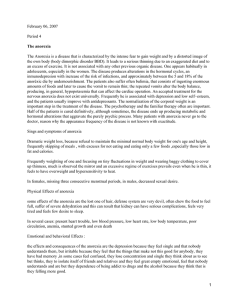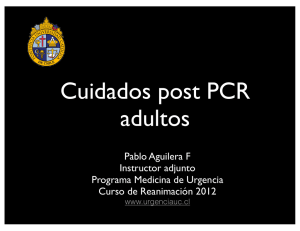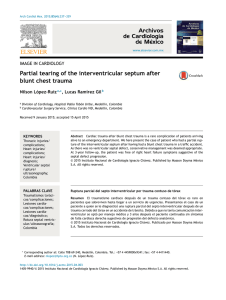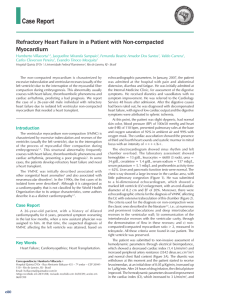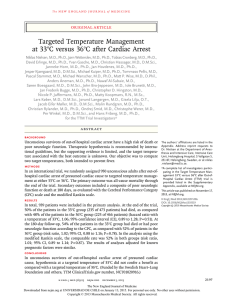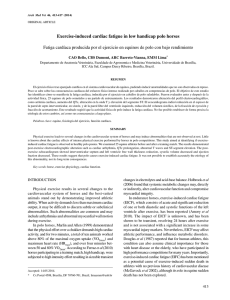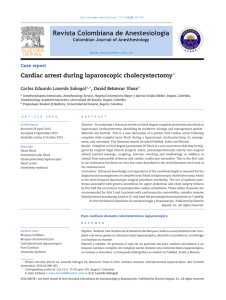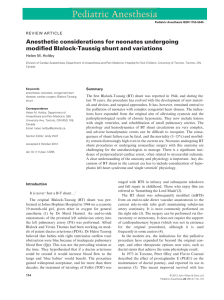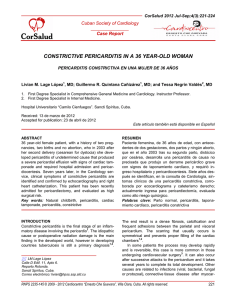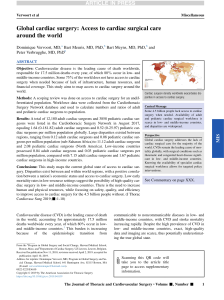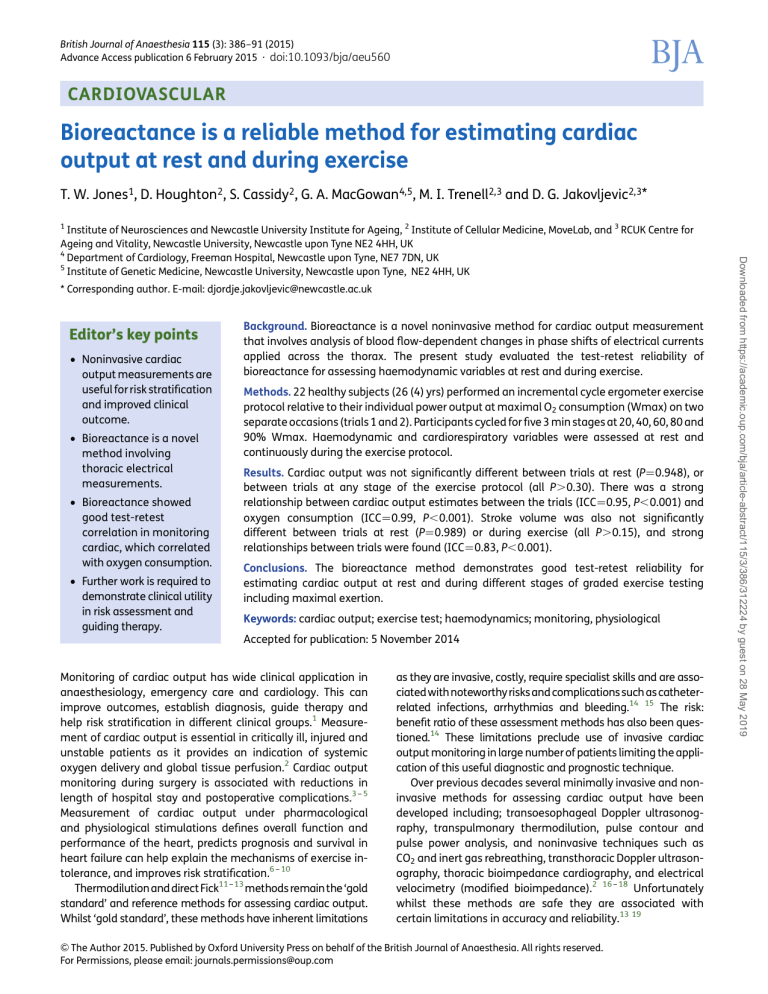
British Journal of Anaesthesia 115 (3): 386–91 (2015) Advance Access publication 6 February 2015 . doi:10.1093/bja/aeu560 CARDIOVASCULAR Bioreactance is a reliable method for estimating cardiac output at rest and during exercise T. W. Jones 1, D. Houghton2, S. Cassidy 2, G. A. MacGowan 4,5, M. I. Trenell 2,3 and D. G. Jakovljevic 2,3* 1 * Corresponding author. E-mail: [email protected] Editor’s key points † Noninvasive cardiac output measurements are useful for risk stratification and improved clinical outcome. † Bioreactance is a novel method involving thoracic electrical measurements. † Bioreactance showed good test-retest correlation in monitoring cardiac, which correlated with oxygen consumption. † Further work is required to demonstrate clinical utility in risk assessment and guiding therapy. Background. Bioreactance is a novel noninvasive method for cardiac output measurement that involves analysis of blood flow-dependent changes in phase shifts of electrical currents applied across the thorax. The present study evaluated the test-retest reliability of bioreactance for assessing haemodynamic variables at rest and during exercise. Methods. 22 healthy subjects (26 (4) yrs) performed an incremental cycle ergometer exercise protocol relative to their individual power output at maximal O2 consumption (Wmax) on two separate occasions (trials 1 and 2). Participants cycled for five 3 min stages at 20, 40, 60, 80 and 90% Wmax. Haemodynamic and cardiorespiratory variables were assessed at rest and continuously during the exercise protocol. Results. Cardiac output was not significantly different between trials at rest (P¼0.948), or between trials at any stage of the exercise protocol (all P.0.30). There was a strong relationship between cardiac output estimates between the trials (ICC¼0.95, P,0.001) and oxygen consumption (ICC¼0.99, P,0.001). Stroke volume was also not significantly different between trials at rest (P¼0.989) or during exercise (all P.0.15), and strong relationships between trials were found (ICC¼0.83, P,0.001). Conclusions. The bioreactance method demonstrates good test-retest reliability for estimating cardiac output at rest and during different stages of graded exercise testing including maximal exertion. Keywords: cardiac output; exercise test; haemodynamics; monitoring, physiological Accepted for publication: 5 November 2014 Monitoring of cardiac output has wide clinical application in anaesthesiology, emergency care and cardiology. This can improve outcomes, establish diagnosis, guide therapy and help risk stratification in different clinical groups.1 Measurement of cardiac output is essential in critically ill, injured and unstable patients as it provides an indication of systemic oxygen delivery and global tissue perfusion.2 Cardiac output monitoring during surgery is associated with reductions in length of hospital stay and postoperative complications.3 – 5 Measurement of cardiac output under pharmacological and physiological stimulations defines overall function and performance of the heart, predicts prognosis and survival in heart failure can help explain the mechanisms of exercise intolerance, and improves risk stratification.6 – 10 Thermodilution and direct Fick11 – 13 methods remain the ‘gold standard’ and reference methods for assessing cardiac output. Whilst ‘gold standard’, these methods have inherent limitations as they are invasive, costly, require specialist skills and are associated with noteworthy risks and complications such as catheterrelated infections, arrhythmias and bleeding.14 15 The risk: benefit ratio of these assessment methods has also been questioned.14 These limitations preclude use of invasive cardiac output monitoring in large number of patients limiting the application of this useful diagnostic and prognostic technique. Over previous decades several minimally invasive and noninvasive methods for assessing cardiac output have been developed including; transoesophageal Doppler ultrasonography, transpulmonary thermodilution, pulse contour and pulse power analysis, and noninvasive techniques such as CO2 and inert gas rebreathing, transthoracic Doppler ultrasonography, thoracic bioimpedance cardiography, and electrical velocimetry (modified bioimpedance).2 16 – 18 Unfortunately whilst these methods are safe they are associated with certain limitations in accuracy and reliability.13 19 & The Author 2015. Published by Oxford University Press on behalf of the British Journal of Anaesthesia. All rights reserved. For Permissions, please email: [email protected] Downloaded from https://academic.oup.com/bja/article-abstract/115/3/386/312224 by guest on 28 May 2019 Institute of Neurosciences and Newcastle University Institute for Ageing, 2 Institute of Cellular Medicine, MoveLab, and 3 RCUK Centre for Ageing and Vitality, Newcastle University, Newcastle upon Tyne NE2 4HH, UK 4 Department of Cardiology, Freeman Hospital, Newcastle upon Tyne, NE7 7DN, UK 5 Institute of Genetic Medicine, Newcastle University, Newcastle upon Tyne, NE2 4HH, UK Reliability of bioreactance during graded exercise Methods Experimental procedures were approved by the Faculty’s Research Ethics Committee in accordance with the Declaration of Helsinki. In all subjects, after being informed of the benefits and potential risks of the investigation all subjects completed a standardized health-screening questionnaire, undertook a resting electrocardiogram and gave their written informed consent. Twenty two healthy subjects (10 male, 12 female) participated. All were non-smokers and free from any cardiac and respiratory disorders. Subjects attended the exercise laboratory on 2 separate days: day 1 involved an initial assessment of maximal aerobic capacity (V̇ O2 max ) and day 2 required 2 visits consisting of an incremental exercise cycle ergometer protocol at individual pre-determined workloads based on power output at V̇ O2 max (Wmax). Subjects abstained from eating for a .2 h before each test and from vigorous exercise 24 h prior. Subjects were instructed not to consume alcohol or caffeine containing foods and beverages on test days. Subjects completed a maximal progressive exercise test on an electromagnetically braked recumbent cycle ergometer (Corival, Lode, Groningen, Netherlands). Subjects began cycling against a resistance of 40 W, this increased continually throughout the test 15 W min21. The assessment ceased when subjects reached volitional exhaustion or were unable to maintain a cadence of 60–70 revolutions min21. Maximal effort was achieved if subjects met any two of the following criteria: i) a change in V̇ O2 ,2 ml kg21 min21 across two stages of the incremental test; ii) a respiratory exchange ratio of ≥1.15 or greater, or iii) ≥90% age predicted maximum heart rate (220-age).28 Expired gases were measured via online metabolic gas exchange system (Cortex metalyser 3B, Leipzig, Germany) and heart rate was measured via short range telemetry (Polar RS400, Finland). Peak oxygen consumption was defined as the average oxygen uptake during the last minute of exercise. Wmax was defined as the power output expressed in W at the point at which subjects reached their individual V̇ O2 max . Exercise protocol was performed twice on study day 2 with ≥3 h interval between trials 1 and 2. Subjects were required to complete five 3 min stages (equating to 15 min of cycling) at intensities relative to 20, 40, 60, 80 and 90% Wmax. Cardiac and haemodynamic responses including cardiac output, cardiac index, stroke volume and stroke volume index, and heart rate were recorded at rest and throughout the incremental exercise protocol using a noninvasive bioreactance system (NICOMw, Cheetah Medical, Delaware, USA). Simultaneously, respiratory and gas exchange measurements were recorded (Cortex metalyser 3B, Leipzig, Germany). The bioreactance system comprises of a radiofrequency generator that creates a high frequency current across the thoracic cavity. The NICOMw has been described previously.19 20 25 It analyses the relative phase shift of current across the thorax using four dual surface electrodes. The skin was prepared by shaving where required and using adhesive paper to ensure an optimal signal from the electrodes. Two electrodes were placed over the trapezius muscle on either side of the upper torso and two on the lower posterior torso lateral to the margin of the latissimus dorsi musculature. The right and left sensors of the device generate independent signals that are subsequently integrated to generate the final signal analysed. Blood present in the thoracic cavity absorbs electrons, which results in a delay in the signal proportional to the volume of blood flow. This is called a phase shift that is translated to blood flow. The signal is then processed separately and 387 Downloaded from https://academic.oup.com/bja/article-abstract/115/3/386/312224 by guest on 28 May 2019 Bioreactance, a novel method for continuous noninvasive cardiac output monitoring, has received increased attention in clinical and research practice in the recent years. The bioreactance method estimates cardiac output by analysing the frequency of relative phase shift of electronic current across the thorax.20 21 In contrast to impedance cardiography which is based on analysis of transthoracic voltage amplitude changes in response to high frequency current, bioreactance analyses frequency spectra variations of delivered oscillating current.20 This approach result in improved precision of the bioreactance system as demonstrated by a 100-fold larger signal-to-noise ratio than that of bioimpedance, making it less susceptible to interference from adipose tissue, electrode placement and excessive movement.20 22 The ability of bioreactance to monitor rapid changes in blood flow has recently been confirmed by Marik and colleagues.23 We compared carotid Doppler ultrasonography against bioreactance in patients with unstable cardiac conditions during passive leg raising. A strong correlation was reported in blood flow between the two methods in critically ill patients, with an accelerated response to these volume changes reported by bioreactance. Bioreactance cardiac output monitoring has been used in intensive care, during and after cardiac surgery, patients with chronic obstructive pulmonary disease and healthy individuals.19 20 22 – 25 Other studies demonstrated that bioreactance measurements of cardiac output at rest and during exertion can identify cardiovascular function abnormalities, indexing disease severity, help prognosis and risk stratification, and track responses to treatment.26 27 When assessing cardiac output at rest or during physiological challenge, it is essential that methods demonstrate acceptable reliability, (i.e. test-retest reliability which refers to reproducibility of a variable when measured in the same subject twice). This is important because even small changes in cardiac output and stroke volume can have significant clinical implications when evaluating the effect of pharmacological and non-pharmacological interventions and risk stratification. The test-retest reliability of bioreactance, as a novel and potent method for noninvasive continuous cardiac output monitoring, has not been evaluated. Based on its higher signal-to-noise ratio and improved performance,19 20 we hypothesize that bioreactance demonstrates acceptable test-retest reliability for evaluating cardiac output at rest and during physiological stimulation such as graded exercise testing. Additionally, we evaluated the association between cardiac output and oxygen consumption at peak exercise. BJA BJA averaged after digital processing at 30 or 60 s intervals. The signal processing unit of the NICOMw determines the relative phase shift (Dw) between input signals relative to the output signal. The Dw is in response to any changes in blood flow that pass through the aorta. Cardiac output is then derived by Cardiac output¼(C×VET×Dw dtmax)×HR, where C is the constant of proportionality and VET is ventricular ejection fraction time.19 The value of C has been previously validated to account for patient age, gender, height and weight.22 stroke volume can then be calculated from cardiac output and HR. Statistical methods Table 1 Cardiac and respiratory data obtained at rest and during the incremental exercise protocol. P value determined from test-retest data using paired sample t-test for measurement outcomes. Data analyses performed on resting and exercise data combined (n¼22, data points¼132). Mean (SD) data are shown Variable Trial 1 Trial 2 t-test (P-value) Cardiac output (litre min21) 13.7 (4.4) 13.4 (4.1) 0.518 Heart rate (beats min21) 123.7 (37.8) 124.3 (36.7) 0.905 Stroke volume (ml beat21) 112.9 (22.5) 109.5 (18.7) 0.179 46.2 (30.0) 47.6 (30.3) 0.732 1.6 (0.9) 1.6 (0.9) 0.882 Minute ventilation (litre min21) Oxygen consumption (litre min21) Table 2 Relative reliability statistics for cardiac and respiratory data at rest and during the incremental exercise protocol. *Significant correlation between trials 1 and 2 (P,0.001). Data analyses performed on resting and exercise data combined (n¼22, data points¼132) Variable Intra-class correlation coefficient Cardiac output (litre min21) 0.95* Heart rate (beats min21) 0.99* Stroke volume (ml beat21) 0.88* Minute ventilation (litre min21) 0.99* Oxygen consumption (litre min21) 0.99* Results Physical characteristics of study subjects were: age 26.3 (4.2) yrs, height 172(8) cm, body mass 67.4 (7.9) kg, and peak V̇ O2 41.5 (8.7) ml kg21 min21. Data pertaining to the systemic bias between trials for all assessed cardiac and respiratory variables are presented in Table 1. There was a no significant (.5%) difference between trials 1 and 2 for all variables (P.0.05). Reliability statistics for cardiac and respiratory responses to the incremental exercise protocol are presented in Tables 2 and 3. These data demonstrate strong relative (Table 2) and test-retest absolute (Table 3) reliability. Cardiac output was similar between the trials 1 and 2 at rest (0.7 (10.3) %) and all stages of the incremental exercise protocol (Fig. 1). At low exercise intensity (20 –40% of Wmax) the differences in cardiac output between trials 1 and 2 were 4 and 1%, respectively. At moderate (60% of Wmax and high (80 and 90% of Wmax) exercise intensity the difference was only 1–2% (Fig. 1). No significant differences between the trial 1 and 2 were reported for SV at all stages of the protocol (Fig. 2). When resting and exercise data points are considered together (n¼132), the mean difference between trial 1 and 2 was only 2%. 388 Mean cardiac index and SVI were not significantly different between trials when data analyses included combined resting and exercise data (Table 1). Furthermore, neither mean cardiac index nor SVI was significantly different between trials at rest or at any exercise stage. As detailed in Table 1, HR, peak V̇ O2 , and mean ventilation were similar between trials. Relative and absolute reliability statistics presented in Tables 2 and 3 demonstrate good reliability. In addition, no significant differences between trials were found in HR, peak V̇ O2 , and mean ventilation at rest or at any of the exercise intensities (P.0.05). There was a strong relationship between cardiac output and V̇ O2 at peak exercise for both trials (Trial 1; r¼0.64, P¼0.001, Trial 2; r¼0.66, P,0.001). Discussion The primary finding of this study is that bioreactance demonstrates acceptable test-retest reliability for estimating cardiac output and SV at rest and during physiological stress induced by exercise testing. Additionally, the exercise protocol used in the present study elicited similar cardiorespiratory Downloaded from https://academic.oup.com/bja/article-abstract/115/3/386/312224 by guest on 28 May 2019 Statistical analyses were performed using PASW statistical analysis software (Version 19, IBM, USA). Data are presented as mean (SD). An alpha level of 0.05 was set before data analysis, and normality of distribution was assessed using a Kolmogorov-Smirnov test. Relative reliability was determined using intra-class correlation coefficients (ICC), calculated using the two-way random method previously described by Weir.29 Absolute reliability was determined using standard error of mean (SEM) with 95% confidence intervals (95% CI), which were calculated independently of intraclass correlation coefficients. Systemic bias in the repeatability between trials was assessed using paired sample t-tests. The relationship between cardiac output and V̇ O2 was assessed with Pearson’s coefficient of correlation. Data analyses were performed on both combined resting and exercise data and data from each individual stage of the incremental exercise protocol for cardiac output, cardiac index, stoke volume (SV), stroke volume index (SVI), heart rate (HR), minute ventilation (VE) and V̇ O2 . Jones et al. BJA Reliability of bioreactance during graded exercise Table 3 Absolute reliability statistics for cardiac and respiratory data at rest and during the incremental exercise protocol. SEM, standard error of the mean; SRD, smallest real difference. Data analyses performed on resting and exercise data combined (n¼22, data points¼132) Variable Change in mean (%) 95% CI Cardiac output (litre min21) 11.1 (0.7) 6.7 (6.4) Heart rate (beats min21) Stroke volume (ml beat21) Sx SRD (3.0) 1.2 (26.3) 10.3 9.8 (3.5) (14.6) 5.7 12.0 (5.4) (21.3) 8.4 Oxygen consumption (litre min21) 12.1 (0.2) (0.7) 0.3 Minute ventilation (litre min21) inexpensively and without specialist training of the assessor permits application to an increased number of patient groups compared with more invasive and ‘gold standard’ catheter based measurement techniques.11 12 The cardiac output values reported here are consistent with recent research using bioreactance in a comparable population and at similar exercise intensities.19 Jakovljevic, and colleagues19 reported resting cardiac output of 6.5 litre min21, similar to that reported. Similar values were also reported at comparable submaximal and near maximal exercise intensities. The cardiac output data previously reported19 consistently correlated with cardiac output estimates derived from measured oxygen consumption.31 We also demonstrate a strong relationship between cardiac output and V̇ O2 at peak exercise. Elliott, and colleagues25 also reported similar cardiac output assessed by bioreactance at similar exercise intensities as the present study and a previous study.19 Resting and near maximal cardiac index reported in the present study is similar to that previously reported,25 further substantiating the previous work19 25 and demonstrating that bioreactance is accurate and reliable for assessing haemodynamic variables at various exercise intensities. Furthermore, our cardiac output data particularly those for stages of low to moderate exercise intensities, are consistent with data in different stages of heart failure.26 27 Overall, our data indicate that bioreactance can provide reliable measures of cardiac output independent of other physiological measures (e.g. V̇ O2 ) and potential elevated electrical noise, body motion, perspiration and body temperature associated with graded exercise. The present study is not without limitations. Firstly, study subjects were young, healthy adults whereas older people and those with chronic conditions were not included such that the present findings might not be generalized to wider 23.00 P=0.780 21.00 P=0.566 Cardiac output (L min–1) P=0.583 19.00 P=0.646 17.00 P=0.312 15.00 13.00 11.00 P=0.948 9.00 7.00 5.00 Rest 20% Pmax 40% Pmax 60% Pmax 80% Pmax 90% Pmax (47.8±10.1) (95.6±20.2) (143.5±30.3) (191.5±40.4) (215.2±45.5) Stage of incremental exercise protocol (workload during stage W) Trial 1 Trial 2 Fig 1 Mean cardiac output at rest and at individual stages of the incremental exercise protocol on trials 1 and 2. Wmax¼power output in Watts (W) at V̇ O2 max x (n¼22). 389 Downloaded from https://academic.oup.com/bja/article-abstract/115/3/386/312224 by guest on 28 May 2019 responses between trials and a strong relationship was identified between cardiac output and peak V̇ O2 for both trials. This illustrates the ability of the exercise protocol to elicit reliable haemodynamic and cardiorespiratory responses on separate occasions in the absence of changes in health and clinical status of an individual. The assessment of cardiac output in a reliable manner is essential to accurately assess improvements or decrements in cardiac function. This is of particular importance in cardiac patients as small changes in cardiopulmonary function attributable to disease or intervention can have significant clinical implications.30 Therefore inaccurate and unreliable measures can contribute to misinterpretations and potentially misdiagnosis. The excellent reliability of bioreactance in measuring haemodynamics (at rest and continuously during exercise) reported in the present study illustrates its potential clinical application. Its ability to assess cardiac output noninvasively, BJA Jones et al. 160 P=0.152 150 P=0.517 P=0.566 Stoke volume (L min–1) 140 130 P=0.989 P=0.783 P=0.717 120 110 100 90 80 60 Rest 20% Wmax 40% Wmax 60% Wmax 80% Wmax 90% Wmax (47.8±10.1) (95.6±20.2) (143.5±30.3) (191.5±40.4) (215.2±45.5) Stage of incremental exercise protocol (workload during stage W) Trial 1 Trial 2 Fig 2 Mean stroke volume at rest and at individual stages of the incremental exercise protocol on trials 1 and 2. Wmax¼power output in Watts (W) at V̇ O2 max (n¼22). clinical applications. However, the study protocol allowed analysis of bioreactance cardiac output test-retest reliability not only at peak exercise but also at low to moderate levels of exercise intensities that are often observed in individuals with chronic conditions and in older people. Secondly, no gold standard for cardiac output measurement (i.e. thermodilution or direct Fick) was included. The additional risks posed to study subjects with these procedures precluded them from being undertaken. In conclusion, bioreactance demonstrates good test-retest reliability for estimating cardiac output and SV at rest and during graded exercise testing including maximal exertion. Future large studies are warranted to assess the reliability of bioreactance at both rest and exercise in different clinical groups where monitoring of cardiac output might improve risk stratification and clinical outcomes. Authors’ contributions Study conceived and designed by D.G.J., T.W.J. and D.H. Data collection performed by D.G.J., T.W.J., D.H. and S.C. Data extraction and analyses performed by T.W.J. Interpretation of data and preparation of manuscript performed by D.G.J., T.W.J., D.H., S.C., G.A.M. and M.I.T. T.W.J. and D.G.J. take responsibility for the content of the manuscript, including the data and analysis. Declaration of interest T.W.J., D.H., M.I.T., S.C., G.A.M. and D.G.J. report no conflict of interests. 390 Funding This work was supported by the UK National Institute for Health Research Biomedical Research Centre for Ageing and Agerelated Diseases award to Newcastle upon Tyne Hospitals NHS Foundation Trust. M.I.T. is supported by the UK National Institute for Health Research Senior Research Fellowship. D.G.J. is supported by the Research Councils UK Centre for Ageing and Vitality. The funding sources did not have a direct role in the design, collection, analysis or interpretation of data, nor in the manuscript preparation, which is solely the remit of the authors. References 1 Jhanji S, Dawson J, Pearse RM. Cardiac output monitoring: basic science and clinical application. Anaesthesia 2008; 63: 172 – 81 2 Marik PE. Noninvasive cardiac output monitors: a state-of the-art review. J Cardiothorac Vasc Anesth 2013; 27: 121–34 3 Venn R, Steele A, Richardson P, Poloniecki J, Grounds M, Newman P. Randomized controlled trial to investigate influence of the fluid challenge on duration of hospital stay and perioperative morbidity in patients with hip fractures. Br J Anaesth 2002; 88: 65 –71 4 Gan TJ, Soppitt A, Maroof M, et al. Goal-directed intraoperative fluid administration reduces length of hospital stay after major surgery. Anesthesiology 2002; 97: 820– 6 5 Sinclair S, James S, Singer M. Intraoperative intravascular volume optimisation and length of hospital stay after repair of proximal femoral fracture: randomised controlled trial. BrMed J 1997; 315: 909– 12 6 Wilson JR, Hanamanthu S, Chomsky DB, Davis SF. Relationship between exertional symptoms and functional capacity in patients with heart failure. J Am Coll Cardiol 1999; 33: 1943–7 Downloaded from https://academic.oup.com/bja/article-abstract/115/3/386/312224 by guest on 28 May 2019 70 Reliability of bioreactance during graded exercise 20 Keren H, Burkhoff D, Squara P. Evaluation of a noninvasive continuous cardiac output monitoring system based on thoracic bioreactance. Am J Physiol 2007; 293: H583–H9 21 Jakovljevic DG, Trenell MI. Bioimpedance and bioreactance methods for monitoring cardiac output. Best Prac & Res Clin Anaesth 2014; 28: 381–94 22 Squara P, Denjean D, Estagnasie P, Brusset A, Dib JC, Dubois C. Noninvasive cardiac output monitoring (NICOM): a clinical validation. Intensive Care Med 2007; 33: 1191–4 23 Marik PE, Levitov A, Young A, Andrews L. The Use of Bioreactance and Carotid Doppler to Determine Volume Responsiveness and Blood Flow Redistribution Following Passive Leg Raising in Hemodynamically Unstable Patients. CHEST 2013; 143: 364–70 24 Ballestero Y, López-Herce J, Urbano J, et al. Measurement of cardiac output in children by bioreactance. Pediatr Cardiol 2011; 32: 469– 72 25 Elliott A, Hull JH, Nunan D, Jakovljevic DG, Brodie D, Ansley L. Application of bioreactance for cardiac output assessment during exercise in healthy individuals. Eur J Appl Physiol 2010; 109: 945– 51 26 Maurer MM, Burkhoff D, Maybaum S, et al. A multicenter study of noninvasive cardiac output by bioreactance during symptomlimited exercise. J Card Fail 2009; 15: 689– 99 27 Rosenblum H, Helmke S, Williams P, et al. Peak cardiac power measured noninvasively with a bioreactance technique is a predictor of adverse outcomes in patients with advanced heart failure. Congestive Heart Failure 2010; 16: 254–8 28 Winter EM, Jones AM, Davison RCR, et al. Sport and Exercise Physiology Testing Guidelines: Volume I– Sport Testing: The British Association of Sport and Exercise Sciences Guide. London: Routledge, 2006; 1– 98 29 Weir JP. Quantifying test-retest reliability using the intraclass correlation coefficient and the SEM. J Stren Cond Res 2005; 19: 231– 7 30 Meyer K, Westbrook S, Schwaibold M, Hajric R, Peters K, Roskamm H. Short-term reproducibility of cardiopulmonary measurements during exercise testing in patients with severe chronic heart failure. Am Heart J 1997; 134: 20– 6 31 Stringer WW, Hansen JE, Wasserman K. Cardiac output estimated noninvasively from oxygen uptake during exercise. J Appl Physiol 1997; 82: 908–12 Handling editor: H. C. Hemmings 391 Downloaded from https://academic.oup.com/bja/article-abstract/115/3/386/312224 by guest on 28 May 2019 7 Chomsky DB, Lang CC, Rayos GH, et al. Hemodynamic Exercise Testing A Valuable Tool in the Selection of Cardiac Transplantation Candidates. Circulation 1996; 94: 3176– 83 8 Tan LB. Cardiac pumping capability and prognosis in heart failure. Lancet 1986; 328: 1360–3 9 Williams SG, Cooke GA, Wright DJ, et al. Peak exercise cardiac power output; a direct indicator of cardiac function strongly predictive of prognosis in chronic heart failure. Eur Heart J 2001; 22: 1496 – 503 10 Lang CC, Karlin P, Haythe J, Lim TK, Mancini DM. Peak cardiac power output, measured noninvasively, is a powerful predictor of outcome in chronic heart failure. Circ Heart Fail 2009; 2: 33–8 11 Lund-Johansen P. The dye dilution method for measurement of cardiac output. Eur Heart J 1990; 11: 6 –12 12 Gawlinski A. Measuring cardiac output: intermittent bolus thermodilution method. Critical Care Nurse 2004; 24: 74–8 13 Warburton DER, Haykowsky MJF, Quinney HA, Humen DP, Teo KK. Reliability and validity of measures of cardiac output during incremental to maximal aerobic exercise. Sports Med 1999; 27: 23–41 14 Sandham JD, Hull RD, Brant RF, et al. A randomized, controlled trial of the use of pulmonary-artery catheters in high-risk surgical patients. N Engl J Med 2003; 348: 5– 14 15 Harvey S, Stevens K, Harrison D, et al. An evaluation of the clinical and cost-effectiveness of pulmonary artery catheters in patient management in intensive care: a systematic review and a randomised controlled trial. Health Technol Assess (Winch Eng) 2006; 10: iii– iv, ix-xi, 1– 133 16 Mathews L, Singh KR. Cardiac output monitoring. Ann Card Anaesth 2008; 11: 56–68 17 Critchley LA, Lee A, Ho AMH. A critical review of the ability of continuous cardiac output monitors to measure trends in cardiac output. Anesth Analg 2010; 111: 1180–92 18 Jakovljevic DG, Nunan D, Donovan G, Hodges LD, Sandercock GRH, Brodie DA. Comparison of cardiac output determined by different rebreathing methods at rest and at peak exercise. Eur J Appl Physiol 2008; 102: 593–9 19 Jakovljevic DG, Moore S, Hallsworth K, Fattakhova G, Thoma C, Trenell MI. Comparison of cardiac output determined by bioimpedance and bioreactance methods at rest and during exercise. J Clin Monit Comput 2012; 26: 63 –8 BJA
